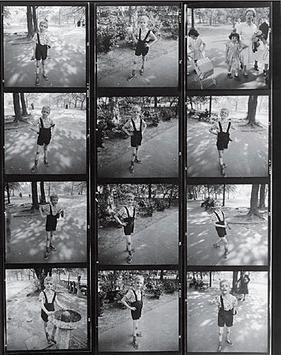Child with Toy Hand Grenade in Central Park


Child with Toy Hand Grenade in Central Park, N.Y.C. 1962 (1962) is a famous photograph by Diane Arbus.
Significance
The photograph Child with Toy Hand Grenade in Central Park, N.Y.C. 1962, by Diane Arbus, shows a boy, with the left strap of his shorts awkwardly hanging off his shoulder, tensely holding his long, stringy, thin arms by his side. Clenched in his right hand is a toy replica hand grenade (an Mk 2 "Pineapple"), his left hand is held in a claw-like gesture, and his facial expression is maniacal.
The contact sheet[1] is "revealing with regards to Arbus' working method. She engages with the boy while moving around him, saying she was trying to find the right angle. The sequence of shots she took depicts a really quite ordinary boy who just shows off for the camera. However, the published single image belies this by concentrating on a freakish posture - an editorial choice typical for Arbus who would invariably pick the most expressive image, thereby frequently suggesting an extreme situation.[2] The boy in the photograph is Colin Wood, son of tennis player Sidney Wood.[3][4] An interview with Colin, with his recollections about the photograph, is presented in the BBC documentary The Genius of Photography.
According to The Washington Post, Colin does not specifically remember Arbus taking the photo, but that he was likely "imitating a face I'd seen in war movies, which I loved watching at the time." Later, as a teenager, he was angry at Arbus for "making fun of a skinny kid with a sailor suit", though he enjoys the photograph now.[3]
She catches me in a moment of exasperation. It's true, I was exasperated. My parents had divorced and there was a general feeling of loneliness, a sense of being abandoned. I was just exploding. She saw that and it's like...commiseration. She captured the loneliness of everyone. It's all people who want to connect but don't know how to connect. And I think that's how she felt about herself. She felt damaged and she hoped that by wallowing in that feeling, through photography, she could transcend herself.
— Colin Wood[3]
In popular culture
After writing the song "Teach Your Children" in 1968 and recording it, Graham Nash discovered this photograph in a San Francisco gallery and found that it related to the song's message about nonviolence.[5][6] The photograph was used, without permission, on the first version of the cover of Canadian punk band SNFU's 1984 album And No One Else Wanted to Play after the band "found the picture in the library."[7] The image is also used on the cover of American indie rock band Cloud Cult's debut album Who Killed Puck?. An original print of the photograph sold for $408,000 in April 2005 at Christie's in New York.[8]
The director John Waters, who had just completed the film Hairspray, sat for a promotional documentary about himself entitled, "Growing Up John Waters," and immediately tells the off-camera interviewer he "...felt like the kid..." in the picture. Waters prefaces this by saying there's a photograph which they'll "never get to show it cause her estate is very, very picky. I promise you, they'll never give you the rights to show it." They did.
During a lecture at New Mexico State University in 1989, Matt Groening told the audience he based the character of Bart Simpson of the TV show The Simpsons upon this photograph. The image was included in the lecture.[citation needed]
Collections
- Jointly held by Tate[9] and National Galleries of Scotland, UK[10]
- Metropolitan Museum of Art, New York[11]
See also
References
- ^ Published in Diane Arbus: Revelations, 2003, p. 164, and online in the article Paris Photo 6 : Diane Arbus à la galerie Robert Miller Archived 2016-05-12 at the Wayback Machine, 2006.
- ^ Bissell, Gerhard. "Arbus, Diane", in Allgemeines Künstlerlexikon (World Biographical Dictionary of Artists), 2006, and "Diane Arbus" (condensed English version).
- ^ a b c Segal, David. "Double Exposure: a Moment With Diane Arbus Created a Lasting Impression." Washington Post, May 12, 2005. Retrieved February 3, 2010.
- ^ Hart, Hugh. Post-Developments. For the Subject of Arbus' 'Child with a Toy Hand Grenade,' Life Was Forever Altered at the Click of a Shutter. San Francisco Chronicle, October 19, 2003. Retrieved February 7, 2010.
- ^ Nash, Graham. "Graham Nash on Diane Arbus's Child With a Toy Hand Grenade in Central Park, N.Y.C., 1962." Aperture, number 196, page 88, Fall 2009.
- ^ Varga, George. Listening Post. As a Photographer, Graham Nash Still Hears the Music. San Diego Union-Tribune, January 5, 2006. Retrieved February 7, 2010.
- ^ Belke, Marc ("Muc", "muc b"). Punk History Gallery: Album Covers: Original Source of image from SNFU - Nobody Else Wanted to Play (archived discussion thread). Punk History Canada, 2006-04-14 19:20:08. Retrieved 2010-02-05.
- ^ Pitman, Joanna. "Vintage Photography: the Market for Photographs Has Grown Rapidly Since the 1980s." Apollo, November 2005. Retrieved February 7, 2010.
- ^ "Diane Arbus: Child with a Toy Hand Grenade in Central Park, N.Y.C. 1962 1962, printed after 1971" Tate. Accessed 23 November 2016
- ^ "Diane Arbus: Child with a Toy Hand Grenade in Central Park, N.Y.C. 1962" National Galleries of Scotland. Accessed 23 November 2016
- ^ Child with a toy hand grenade in Central Park, N.Y.C. National Galleries of Scotland. Accessed 23 November 2016
